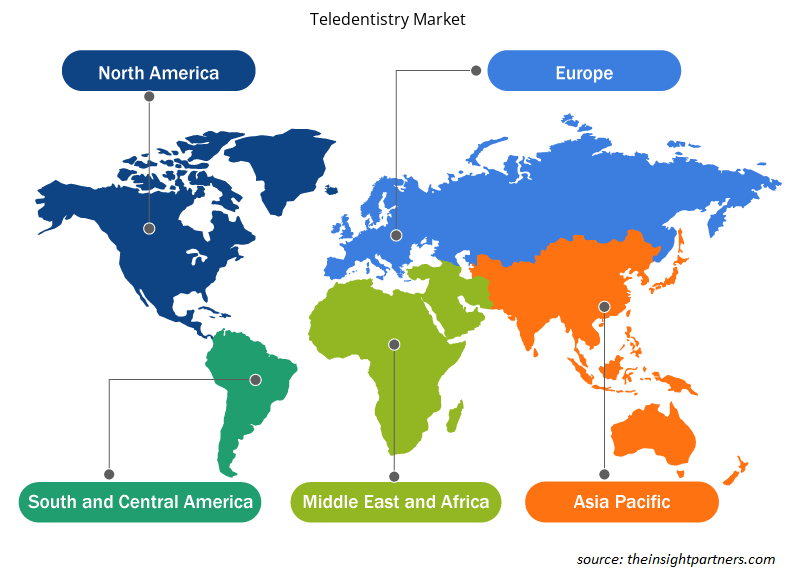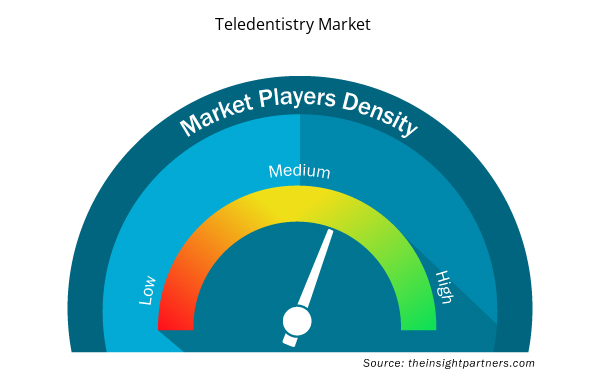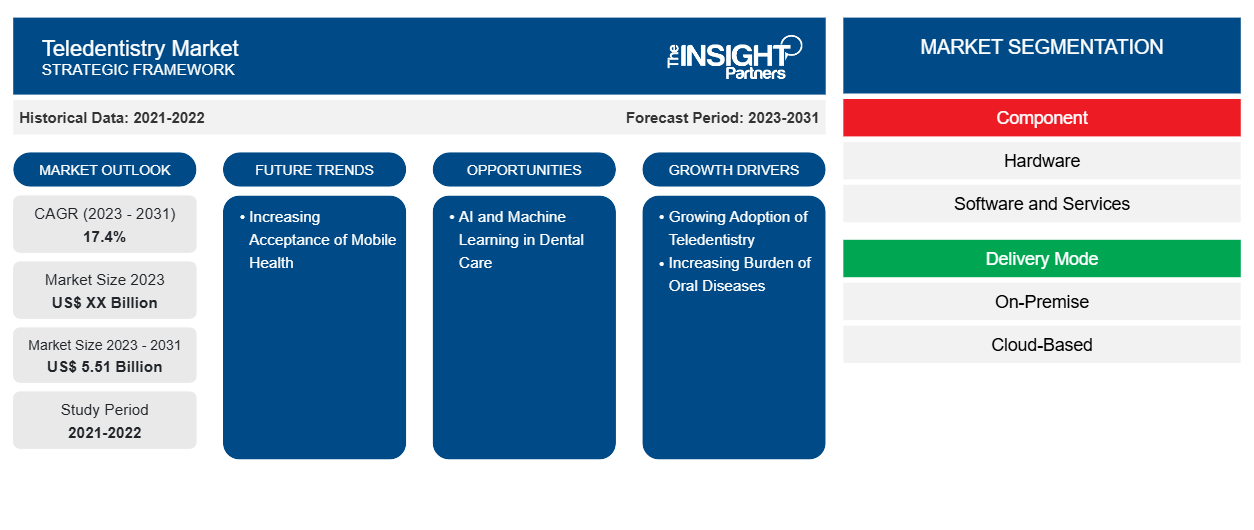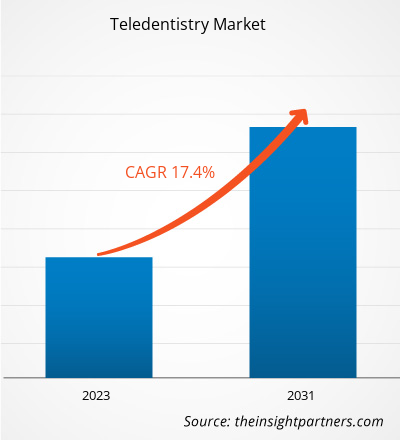La dimensione del mercato della teleodontoiatria nel 2021 era di 1,04 miliardi di dollari USA e si prevede che raggiungerà i 5,51 miliardi di dollari USA entro il 2031 dai XX miliardi di dollari USA nel 2023. Si prevede che il mercato registrerà un CAGR del 17,4% nel 2023-2031. È probabile che la crescente accettazione della salute mobile rimanga una delle principali tendenze del mercato della teleodontoiatria.
Analisi del mercato della teleodontoiatria Market Analysis
La crescita del mercato globale della teleodontoiatria è un risultato diretto dei vantaggi che porta al settore odontoiatrico, come la crescente popolarità delle soluzioni di salute digitale , i progressi nella tecnologia di comunicazione e imaging e la praticità che offre sia ai professionisti del settore odontoiatrico che ai pazienti. I principali attori del mercato stanno investendo in attività strategiche, tra cui acquisizioni, fusioni, collaborazioni e lanci di software per mantenere un vantaggio competitivo, con conseguente crescita del mercato.
Panoramica del mercato della teleodontoiatria
La teleodontoiatria rende l'assistenza sanitaria orale più accessibile, soprattutto nei paesi in via di sviluppo e durante le emergenze. La teleodontoiatria, con l'uso della tecnologia delle telecomunicazioni, consente l'accesso globale a pazienti e dentisti eliminando le barriere regionali. Si prevede che la crescente popolazione anziana, nonché la loro maggiore accettazione delle tecnologie di teleodontoiatria grazie alla loro praticità e convenienza, guideranno l'espansione del settore durante il periodo di previsione. La pandemia di COVID-19 ha avuto un impatto economico positivo significativo sul business della teleodontoiatria a causa dell'aumento della domanda di servizi sanitari virtuali.
Personalizza questo report in base alle tue esigenze
Riceverai la personalizzazione gratuita di qualsiasi report, comprese parti di questo report, o analisi a livello nazionale, pacchetto dati Excel, oltre a usufruire di grandi offerte e sconti per start-up e università
- Scopri le principali tendenze di mercato in questo rapporto.Questo campione GRATUITO includerà analisi di dati che spaziano dalle tendenze di mercato alle stime e alle previsioni.
Driver e opportunità del mercato della teleodontoiatria
Crescente adozione della teleodontoiatria per favorire la crescita del mercato
La teleodontoiatria è una pratica relativamente nuova per i dentisti e mira a fornire ai pazienti un'ampia gamma di soluzioni ricevute a distanza. Con la pandemia di COVID-19, si prevede che l'uso della teleodontoiatria registrerà un aumento costante nei prossimi anni per gestire la pandemia e riprendere le cure di routine. Secondo un rapporto pubblicato da DentaQuest Partnership for is a relatively new practice for the dentists and aims to provide patients with a broad range of solutions that are received from a distance. With the COVID-19 pandemic, the use of Oral Care Advancement a novembre 2020, circa il 23% dei fornitori di servizi odontoiatrici negli Stati Uniti ha iniziato a vedere i pazienti tramite piattaforme virtuali di teleodontoiatria. Inoltre, il sondaggio suggerisce anche che l'11% dei fornitori che attualmente non utilizzano la tecnologia ha in programma di utilizzarla nel prossimo futuro.teledentistry is anticipated to witness a steady increase over the coming years in order to navigate the pandemic as well as to resume routine care. According to a report published by DentaQuest Partnership for teledentistry virtual platforms. Moreover, the survey also suggests that 11% of the providers that are not currently using the technology have plans to use it in the near future.
Intelligenza artificiale e apprendimento automatico nell'assistenza odontoiatrica
L'intelligenza artificiale e l'apprendimento automatico sono componenti essenziali della teleodontoiatria. Forniscono piani di cura personalizzati, diagnosi predittive e aiutano persino nella pianificazione del trattamento con una precisione senza pari. Le consulenze virtuali stanno diventando più avanzate, con diagnosi in tempo reale e sessioni interattive alla pari delle consulenze e visite di persona.teledentistry. They provide personalized care plans, predictive diagnoses, and even help with treatment planning with unparalleled precision. Virtual consultations are becoming more advanced, with real-time diagnostics and interactive sessions on par with in-person consultations and visits.
Analisi della segmentazione del rapporto di mercato sulla teleodontoiatria Market Report Segmentation Analysis
I segmenti chiave che hanno contribuito alla derivazione dell'analisi di mercato della teleodontoiatria sono i componenti, la modalità di consegna e l'utente finale.teledentistry market analysis are component, delivery mode, and end user.
- In base ai componenti, il mercato della teledentistria è diviso in hardware e software e servizi. Il segmento software e servizi ha detenuto una quota di mercato maggiore nel 2023.teledentistry market is bifurcated into hardware, and software & services. The software & services segment held a larger market share in 2023.
- In base alla modalità di distribuzione, il mercato è diviso in on-premise e basato su cloud. Il segmento basato su cloud ha detenuto la quota maggiore del mercato nel 2023.
- In termini di utente finale, il mercato è segmentato in pazienti, pagatori, provider e altri. Il segmento dei provider ha dominato il mercato nel 2023.
Analisi della quota di mercato della teleodontoiatria per area geografica Market Share Analysis by Geography
L'ambito geografico del rapporto sul mercato della teleodontoiatria è suddiviso principalmente in cinque regioni: Nord America, Asia Pacifico, Europa, Medio Oriente e Africa, Sud e Centro America.
Il Nord America ha dominato il mercato della teleodontoiatria. In Nord America, la prosperità economica, la crescita della popolazione e l'invecchiamento della popolazione, insieme a una maggiore attenzione alla salute orale e a una migliore copertura assicurativa (in particolare negli Stati Uniti) sono fattori chiave che determinano una crescita moderata ma costante delle spese odontoiatriche complessive. La teleodontoiatria sta migliorando la salute degli americani, risparmiando denaro perché l'assistenza e l'istruzione possono essere fornite in modo più rapido ed efficiente.
Approfondimenti regionali sul mercato della teleodontoiatria
Le tendenze regionali e i fattori che influenzano il mercato della teledentistria durante il periodo di previsione sono stati ampiamente spiegati dagli analisti di Insight Partners. Questa sezione discute anche i segmenti e la geografia del mercato della teledentistria in Nord America, Europa, Asia Pacifico, Medio Oriente e Africa e Sud e Centro America.

- Ottieni i dati specifici regionali per il mercato della teleodontoiatria
Ambito del rapporto di mercato sulla teleodontoiatria
| Attributo del report | Dettagli |
|---|---|
| Dimensioni del mercato nel 2023 | XX miliardi di dollari USA |
| Dimensioni del mercato entro il 2031 | 5,51 miliardi di dollari USA |
| CAGR globale (2023-2031) | 17,4% |
| Dati storici | 2021-2022 |
| Periodo di previsione | 2023-2031 |
| Segmenti coperti | Per componente
|
| Regioni e Paesi coperti | America del Nord
|
| Leader di mercato e profili aziendali chiave |
|
Densità degli attori del mercato: comprendere il suo impatto sulle dinamiche aziendali
Il mercato della teledentistry sta crescendo rapidamente, spinto dalla crescente domanda degli utenti finali dovuta a fattori quali l'evoluzione delle preferenze dei consumatori, i progressi tecnologici e una maggiore consapevolezza dei benefici del prodotto. Con l'aumento della domanda, le aziende stanno ampliando le loro offerte, innovando per soddisfare le esigenze dei consumatori e capitalizzando sulle tendenze emergenti, il che alimenta ulteriormente la crescita del mercato.
La densità degli operatori di mercato si riferisce alla distribuzione di aziende o società che operano in un particolare mercato o settore. Indica quanti concorrenti (operatori di mercato) sono presenti in un dato spazio di mercato in relazione alle sue dimensioni o al valore di mercato totale.
Le principali aziende che operano nel mercato della teleodontoiatria sono:
- ViDe Virtual Dental,
- Koninklijke Philips NV,
- ITeleDentisti,
- Guarda la bocca LLC,
- Soluzioni Denterattive, Inc.,
- Società Patterson, Inc.,
Disclaimer : le aziende elencate sopra non sono classificate secondo un ordine particolare.

- Ottieni una panoramica dei principali attori del mercato della teleodontoiatria
Notizie e sviluppi recenti del mercato della teleodontoiatria
Il mercato della teleodontoiatria viene valutato raccogliendo dati qualitativi e quantitativi post-ricerca primaria e secondaria, che includono importanti pubblicazioni aziendali, dati associativi e database. Di seguito è riportato un elenco degli sviluppi nel mercato della teleodontoiatria:
- The TeleDentists annuncia la nostra nuova e migliorata piattaforma, alimentata da AmWell. I pazienti possono ora accedere ai servizi TeleDental tramite la piattaforma AmWell Telehealth. I servizi TeleDentists sono disponibili 24 ore su 24, 7 giorni su 7, 365 giorni all'anno, in tutto il paese. (Fonte: The TeleDentists, comunicato stampa, 2023)
- Virtual Dental Care (VDC), i produttori di Teledentix, e Cigna hanno unito le forze per aumentare l'accesso alle cure dentistiche on-demand, comprese le cure di emergenza. Grazie al software sicuro Teledentix di VDC, i clienti Cigna potranno connettersi a un dentista tramite video, testo, chat ed e-mail per un supporto immediato. (Fonte: Teledentix, comunicato stampa, 2022)
- Dentulu ha stretto una partnership con Pearl, vincitrice del premio "Best of Class" per la tecnologia AI del 2022, per consentire ai teledentisti di Dentulu di raggiungere il massimo livello di prestazioni diagnostiche, migliorando al contempo l'esperienza del paziente. (Fonte: Dentulu, Inc., Comunicato stampa, 2023)
Copertura e risultati del rapporto sul mercato della teleodontoiatria
Il rapporto "Dimensioni e previsioni del mercato della teledentistria (2021-2031)" fornisce un'analisi dettagliata del mercato che copre le seguenti aree:
- Dimensioni e previsioni del mercato a livello globale, regionale e nazionale per tutti i segmenti di mercato chiave coperti dall'ambito
- Dinamiche di mercato come fattori trainanti, vincoli e opportunità chiave
- Principali tendenze future
- Analisi dettagliata delle cinque forze PEST/Porter e SWOT
- Analisi di mercato globale e regionale che copre le principali tendenze di mercato, i principali attori, le normative e gli sviluppi recenti del mercato
- Analisi del panorama industriale e della concorrenza che copre la concentrazione del mercato, l'analisi della mappa di calore, i principali attori e gli sviluppi recenti
- Profili aziendali dettagliati
- Analisi storica (2 anni), anno base, previsione (7 anni) con CAGR
- Analisi PEST e SWOT
- Valore/volume delle dimensioni del mercato - Globale, regionale, nazionale
- Industria e panorama competitivo
- Set di dati Excel



Report Coverage
Revenue forecast, Company Analysis, Industry landscape, Growth factors, and Trends

Segment Covered
This text is related
to segments covered.

Regional Scope
North America, Europe, Asia Pacific, Middle East & Africa, South & Central America

Country Scope
This text is related
to country scope.
Trends and growth analysis reports related to Technology, Media and Telecommunications : READ MORE..
The Insight Partners performs research in 4 major stages: Data Collection & Secondary Research, Primary Research, Data Analysis and Data Triangulation & Final Review.
- Data Collection and Secondary Research:
As a market research and consulting firm operating from a decade, we have published and advised several client across the globe. First step for any study will start with an assessment of currently available data and insights from existing reports. Further, historical and current market information is collected from Investor Presentations, Annual Reports, SEC Filings, etc., and other information related to company’s performance and market positioning are gathered from Paid Databases (Factiva, Hoovers, and Reuters) and various other publications available in public domain.
Several associations trade associates, technical forums, institutes, societies and organization are accessed to gain technical as well as market related insights through their publications such as research papers, blogs and press releases related to the studies are referred to get cues about the market. Further, white papers, journals, magazines, and other news articles published in last 3 years are scrutinized and analyzed to understand the current market trends.
- Primary Research:
The primarily interview analysis comprise of data obtained from industry participants interview and answers to survey questions gathered by in-house primary team.
For primary research, interviews are conducted with industry experts/CEOs/Marketing Managers/VPs/Subject Matter Experts from both demand and supply side to get a 360-degree view of the market. The primary team conducts several interviews based on the complexity of the markets to understand the various market trends and dynamics which makes research more credible and precise.
A typical research interview fulfils the following functions:
- Provides first-hand information on the market size, market trends, growth trends, competitive landscape, and outlook
- Validates and strengthens in-house secondary research findings
- Develops the analysis team’s expertise and market understanding
Primary research involves email interactions and telephone interviews for each market, category, segment, and sub-segment across geographies. The participants who typically take part in such a process include, but are not limited to:
- Industry participants: VPs, business development managers, market intelligence managers and national sales managers
- Outside experts: Valuation experts, research analysts and key opinion leaders specializing in the electronics and semiconductor industry.
Below is the breakup of our primary respondents by company, designation, and region:

Once we receive the confirmation from primary research sources or primary respondents, we finalize the base year market estimation and forecast the data as per the macroeconomic and microeconomic factors assessed during data collection.
- Data Analysis:
Once data is validated through both secondary as well as primary respondents, we finalize the market estimations by hypothesis formulation and factor analysis at regional and country level.
- Macro-Economic Factor Analysis:
We analyse macroeconomic indicators such the gross domestic product (GDP), increase in the demand for goods and services across industries, technological advancement, regional economic growth, governmental policies, the influence of COVID-19, PEST analysis, and other aspects. This analysis aids in setting benchmarks for various nations/regions and approximating market splits. Additionally, the general trend of the aforementioned components aid in determining the market's development possibilities.
- Country Level Data:
Various factors that are especially aligned to the country are taken into account to determine the market size for a certain area and country, including the presence of vendors, such as headquarters and offices, the country's GDP, demand patterns, and industry growth. To comprehend the market dynamics for the nation, a number of growth variables, inhibitors, application areas, and current market trends are researched. The aforementioned elements aid in determining the country's overall market's growth potential.
- Company Profile:
The “Table of Contents” is formulated by listing and analyzing more than 25 - 30 companies operating in the market ecosystem across geographies. However, we profile only 10 companies as a standard practice in our syndicate reports. These 10 companies comprise leading, emerging, and regional players. Nonetheless, our analysis is not restricted to the 10 listed companies, we also analyze other companies present in the market to develop a holistic view and understand the prevailing trends. The “Company Profiles” section in the report covers key facts, business description, products & services, financial information, SWOT analysis, and key developments. The financial information presented is extracted from the annual reports and official documents of the publicly listed companies. Upon collecting the information for the sections of respective companies, we verify them via various primary sources and then compile the data in respective company profiles. The company level information helps us in deriving the base number as well as in forecasting the market size.
- Developing Base Number:
Aggregation of sales statistics (2020-2022) and macro-economic factor, and other secondary and primary research insights are utilized to arrive at base number and related market shares for 2022. The data gaps are identified in this step and relevant market data is analyzed, collected from paid primary interviews or databases. On finalizing the base year market size, forecasts are developed on the basis of macro-economic, industry and market growth factors and company level analysis.
- Data Triangulation and Final Review:
The market findings and base year market size calculations are validated from supply as well as demand side. Demand side validations are based on macro-economic factor analysis and benchmarks for respective regions and countries. In case of supply side validations, revenues of major companies are estimated (in case not available) based on industry benchmark, approximate number of employees, product portfolio, and primary interviews revenues are gathered. Further revenue from target product/service segment is assessed to avoid overshooting of market statistics. In case of heavy deviations between supply and demand side values, all thes steps are repeated to achieve synchronization.
We follow an iterative model, wherein we share our research findings with Subject Matter Experts (SME’s) and Key Opinion Leaders (KOLs) until consensus view of the market is not formulated – this model negates any drastic deviation in the opinions of experts. Only validated and universally acceptable research findings are quoted in our reports.
We have important check points that we use to validate our research findings – which we call – data triangulation, where we validate the information, we generate from secondary sources with primary interviews and then we re-validate with our internal data bases and Subject matter experts. This comprehensive model enables us to deliver high quality, reliable data in shortest possible time.


 Ottieni un campione gratuito per questo repot
Ottieni un campione gratuito per questo repot